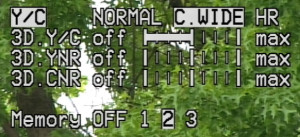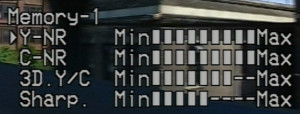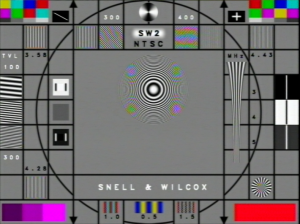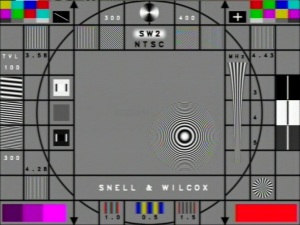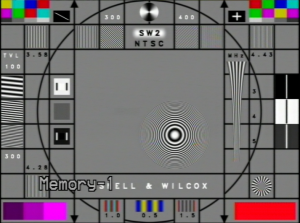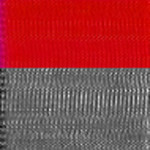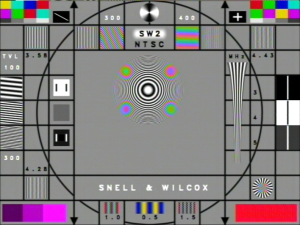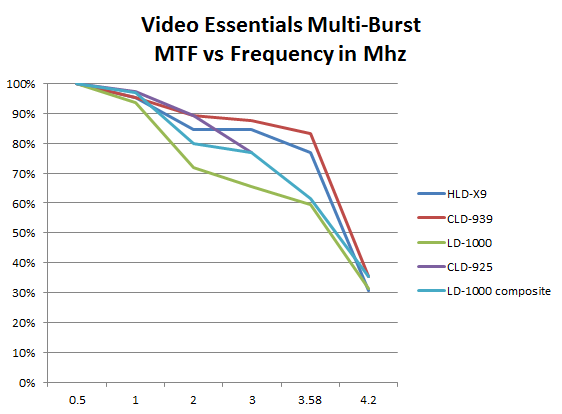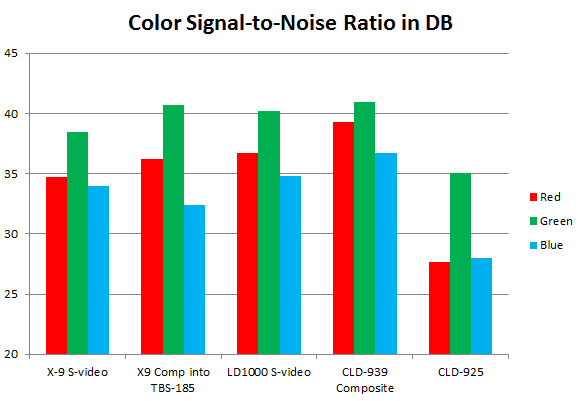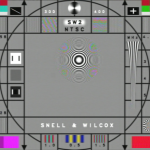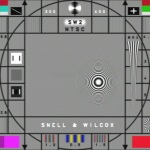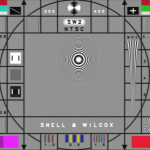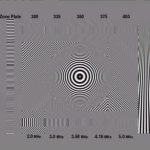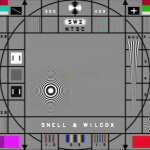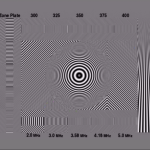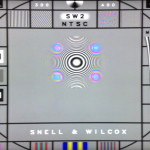With the recent demise of two of my Laserdisc players while writing an article about Se7en, I took the plunge and got a couple of ‘fresh’ ones. Pondering how best to make use of these players got me started thinking about comb filters. I’d always wanted to get a better comb filter to use with my older players, but never got around to doing much about it.
Having a bit of free-time and cash on my hands – I decided to do a bit of group test. During testing I managed to resurrect my two dead players (Hint: 220v players don’t work well for long on 100v !)
The following equipment will be put to the test:
- Pioneer HLD-X9
- Pioneer CLD-D925 (Dual PAL/NTSC player)
- Pioneer CLD-939 (Japanese Pioneer CLD-97)
- Farojida LD-1000 (Tweaked Pioneer CLD-99)
- Leitch DPS-575 (Timebase corrector and 3D comb filter -> SDI)
- Snell and Wilcox TBS-185 Kudos Plus (Timebase corrector and 3D comb filter -> SDI)
- Sony HX-903 LCD Television
- CYP SY-P295N S-video and composite to HDMI converter
Effectively this is a group test of all of these components, which I have seen discussed on many forums – but never actually reviewed !
Understanding Snell and Wilcox SW2 – A Classic Test Pattern
Since I’m going to be grading the comb filters based on the SW2 test pattern – I’ll go quickly through the key features.
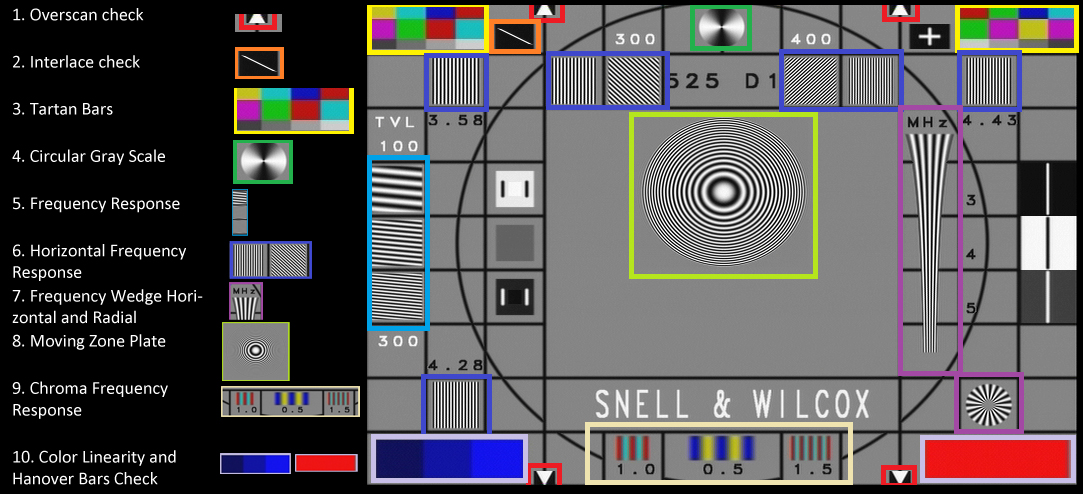
1. The overscan check should show a complete triangle on all the edges.
2. This may show artifacts if there are de-interlacing filter issues.
3. Checking for horizontal and vertical dot crawl
4. Checking for good linearity.
5. This should show any issues in pure frequency response to luma.
6. This patches are tuned to various problem spots of comb filter response. The diagonal 300 and 400 lines are impossible to process without a 3D comb filter.
7. The frequency wedge shows any cross color issues the comb filter may have. This is often well decoded by a 2D comb filter.
8. The nemesis of comb filters, the moving zone plate. A 3D filter will show this perfectly until it moves.
9. Often overlooked. Looking for dot crawl and or dimming of response here.
10. Hanover bars are not generally issues in modern display, but the red area may show dot crawl.
Other Test Material
The Ballerina descending snippet from the Video Essentials Laserdisc seems to kill all kinds of comb filters. The background is about the same Luma value as the Ballerina’s arms, while at various points her skin and the background are complimentary colors.
2D comb filters display horrible dot crawl during this sequence, and 3D comb filters may not detect the ballerinas arm moving due to the similar Luma value, and incorrectly process her arm as being the same as the background resulting in temporal smearing.
The second piece of test material is BBC Test Card G from the PAL CAV Laserdisc of Jason and the Argonauts. This only features a static frequency sweep, but it’s all I have to hand in the PAL space.
A third item is the AVIA DVD test disc, which includes the mother of all zone plate patterns.
Laserdisc Player Reviews
Pioneer HLD-X9 First Impressions
The HLD-X9 is generally regarded as the best ‘two-side’ laserdisc player ever made. The HLD-X0, is frequently credited with having an even better picture, but at the expense of only being able to play a single side of a disc. A review of the service manual led me to believe that the electronic side of the X0 is more complex, while being of equivalent effectiveness to the X9. Given I’d just had two laserdisc players die, I was looking for something that was going to last for a long time, and the X9 fit that bill better.
The X9 is large and heavy, clocking in at 17 kilograms. All mechanical sounds emerge from the player very mutedly, giving an impression of solidity. Frankly the stellar reputation is well deserved. From the very first disc I spun up I was impressed by the picture coming out of it.
CLV smear is entirely absent compared with other Pioneer players in this review, and while the smear doesn’t show up in every scene, I felt the HLD-X9 seemed to considerably reduce the usual fog of analogue distractions, and I found myself watching the first ten minutes of Alien several times during testing.
Onscreen display options allows you to pick from several comb filter settings NORMAL, WIDE, HR (High Resolution) that are applied to the S-video output, and allows you to adjust each of the 3D comb filter, luma and chroma noise reduction through 6 settings from off to on. I have largely avoided the noise reduction settings, and focused on the comb filter modes.
Material available on the Internet suggested that the comb filter in the HLD-X9 is a Mitsubishi chip used in several of their televisions using a unique 3D comb filtering technique that achieves great results with test patterns, but can give less than desirable artifacting with real world images. I suspect this is due to the incorrect detection of material as 30p rather than 24p resulting in fields being in inappropriately used as input to the 3D filter.
I believe that the key difference between the modes available in the HLD-X9 is the selection of co-efficients for the 3D comb filter, and the adaptivity of the filter.
Walking through each of the modes:
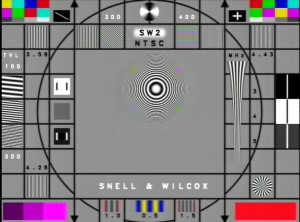
HLD-X9 in HR mode. Note the slight dot-crawl on the 1.5Mhz chroma response, and clean response at 300 diagonal lines, and minor noise at 400. Even when moving the zone plate only shows minor interference.
HR mode works best with test patterns like SW2, but produces the worst artifacting with strongly cross-colored material in particular the Ballerina scene snippet from Video Essentials demonstrates the issues perfectly. I believe the filter in this mode is effectively a non-adaptive 3D filter, with the co-efficients selected to work reasonably well against test patterns with low motion. Certainly the menu option to tweak the 3D filter sensitivity is disabled in this mode.
While the results with test-patterns are hard to deny, the artifacts present on real-world material makes it difficult to recommend it.
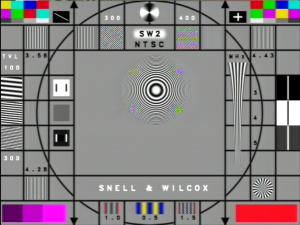
HLD-X9 in C.WIDE mode with all NR off and half 3D Y/C. Zone plate shows some signs of interference when static, and both 300 and 400 line diagonal patterns show noise. Dot crawl at 1.5Mhz chroma response is increased over HR mode.
C.WIDE mode I could not see much difference in performance between this and the ‘Normal’ mode. The manual suggests this is better for fast motion, and may have the 3D filter co-efficients tweaked to lower the input from past and future frames. Certainly the 3D comb artifacts are somewhat reduced in this mode in the Ballerina scene.
C.WIDE mode is probably the best choice to use when transferring material using the X9, where you need to use a 3D comb filter. I would recommend using only one or two notches on the sensitivity scale however.
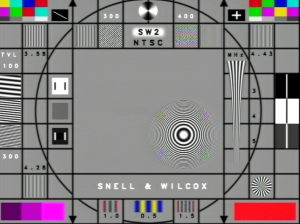
HLD-X9 in ‘Normal’ mode, NR off with half Y/C. Note the greater suppression of artifacts over C.WIDE probably due to highers values placed on temporal coefficients.
Normal mode is a compromise between C.WIDE and HR modes, this doesn’t appear to result in much difference when viewing test-patterns, but results in slightly worse 3D comb artifacts on real-world material like the Ballerina scene.
Stick with C.WIDE if you need to use the internal comb filter with the X9.
From the sounds it makes during disc loading and side changes, the mechanism it appears to be in the same family as the later CLD-99 and CLD-925.
Farojida LD-1000 (Pioneer CLD-99)
Basically this is a tweaked Pioneer CLD-99 in a monster case. Clocking in at 18kg it’s certainly value per kilo.
I discovered an interesting thing that appears to have been overlooked while researching this article: The CLD-99 has the exact same comb filter chip as the HLD-X0. This is somewhat interesting since the HLD-X0 has a pretty well regarded comb filter. Both use the NEC PD6480FG 3D comb filter.
The comb filter settings offer adjustable adapativity from pure 2D to basically fixed 3D combing, with luma and chroma 3D noise-reduction as well as a sharpness setting which apparently doesn’t seem to do anything on my player.
Performance was in general was fair with luma noise levels in line with the rest of the players and good chroma noise performance. Weak spots were sharpness which was considerably worse than any of the other players tested.
The comb performed well but with caveats, adjusting the 3D. Y/C setting to get great performance on the SW2 test-pattern resulted in artifacts in the Ballerina snippet, while turning it down low enough to avoid artifacts meant losing much of the benefit of cross-color elimination.
The comb filter has 9 notches. I’ll ignore the top (3D comb all the time) and the bottom (2D comb all the time) and look at two notches above the bottom, the mid-point and two notches below the top. I’ll call these low – medium and high.
Low mode showed fair performance on the SW2 pattern, with some cross-color on the 400 line diagonal and the zone plate as well as some minor dot-crawl. I could see no significant comb artifacts on the ballerina sequence.
Medium mode showed very good performance on the SW2 pattern, with hardly any cross-color on the stationary zone plate, and only minor noise on the 400 line diagonal. There were some artifacts in the ballerina sequence.
High mode produced a very clean test pattern with the only negative the lack of chroma response at 1.5Mhz which was common to all the modes. The moving zone plate showed cross-color however. Ballerina sequence showed about the same level of artifacts as medium, but I would suspect other sequence might show a bit more.
Given the above I would suggest using two or three bars of 3D Y/C.
Pioneer CLD-939 (CLD-97)
This was a Japanese market player that was ranked number one by an influential AV magazine in the early 1990s. It was later superceded by a slightly upgraded model, the CLD-959 with a better digital audio section. Both appear to be equivalent to the US market CLD-97, which is regarded by many as being the best US market Laserdisc player.
The CLD-939 is also a big player, clocking in at 14 kilograms.
One thing to watch for is the fact it doesn’t have an AC-3 RF out, which might be a problem for you.
The loading mechanism of this player makes a distinctly different sequence of noises to any of the other players I’ve used, suggesting a generational shift between this and the later CLD-99.
The comb filter in the player is a 2D adaptive filter, while it did a better job than the CLD-925, it did not perform as well as Leitch or the S&W processor.
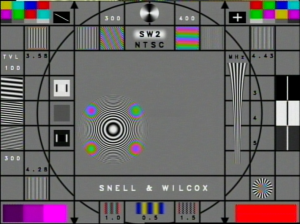
CLD-939, S-video output. Note the 0IRE black level. Cross-color is strongly evident on both the zone plate and diagonal lines. Note the minor interference at the top and bottom of the 3.58 Mhz block.
Ignoring the mediocre comb filter performance for a moment, and looking at the measurement results, it’s actually shocking how good this player is.
In this review it delivers the sharpest picture and has the best chroma noise results of all the players. The CLD-939/959 and CLD-97 players are definately worth considering if you are shopping for a new (well used) Laserdisc player.
Pioneer CLD-D925
The CLD-D925 was one of the last dual format players produced by Pioneer it was followed by a couple of DVD/Laserdisc combination players that don’t have a great reputation. In Europe there was relatively little content released on Laserdisc, but NTSC Laserdiscs were readily available, fueling demand for players that could handle both.
In terms of comb filter, the CLD-D925 has a 3-line 2D adaptive comb filter, which exhibits fair performance, but would likely outclassed by the comb filter in your television. Certainly the 2D comb filters in the other NTSC players outperforms the CLD-D925.
I can see considerable cross-talk interference on test patterns on both the CAV NTSC Video Essentials and the CAV PAL test card on Jason and the Argonauts. It’s possible this is servo noise or some issue with my player, but this is pretty bad, order of magnitude worse than any of the other players. I suspect that my player may have gone out of alignment. Time to break out the service manual.
In terms of playback performance my CLD-D925 was the worst of the pack.
Laserdisc Player Measurements
To eliminate any human frailty from this review, I did some pure numbers testing on the players. These threw up some pretty interesting results. I captured the S-video output of all the players.
The much older, much cheaper CLD-939 is actually sharper than my HLD-X9 ! Also a surprise here is the LD-1000/CLD-99 which is much softer than the other players at relatively low frequency. I was so surprised by this I re-ran the test several time, and adjusted the player’s sharpness setting and 3D YC mode, neither made any difference. The composite output is better, but still way below the other players. Additional video processing may be the root cause here.
The CLD-D925 began aliasing or possibly ringing at 3Mhz, and by 4.2Mhz the output signal was entirely unrepresentative, so I dropped it from the comparison here. I suspect that the digital frame store ADC doesn’t have appropriate filtering which results in a sharper image at lower frequencies, but aliasing at higher ones.
Next a look at luma signal-to-noise ratios:
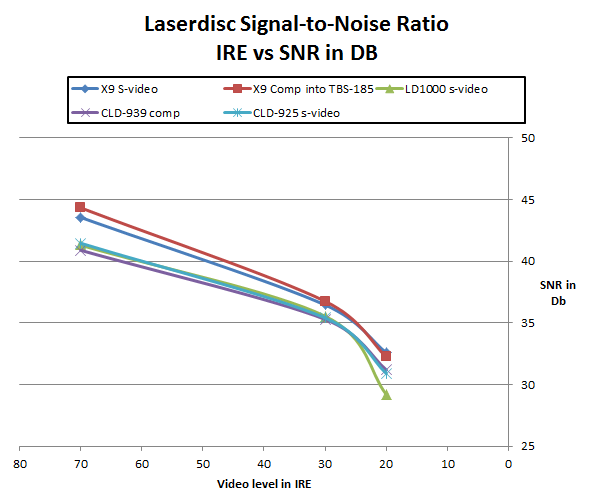
HLD-X9 (HR mode), LD-1000 (CLD-99) No DNR, CLD-939 (CLD-97), CLD-D925. Signal-to-noise ratios measured using 70IRE, 30IRE and 20IRE gray scale on a Pluge pattern on Video Essentials.
The HLD-X9 romped away with this one, with a slight advantage to using the Composite output in a good external comb filter. I’m not clear if this might be down to some fixed noise filtering taking place inside the player for now I’m going to give it the benefit of the doubt.
Please note these are different from the SNRs quoted in various places that are likely NTC-7 standard, which basically measure at 100IRE with (I believe) a 10khz pattern, which as you might be able to work out – will give higher numbers due to the better SNR at higher IRE.
The interesting thing here is how close the players are in performance, only 3db seperates best from worst at most points on the curve, basically even the cheaper players are approaching the limits of the formats performance in luma SNR.
I decided to take a look at chroma noise as well. This was measured using the color bars from Video Essentials, measuring the mean and standard deviation of each of three bars (Red, Green and Blue) in its particular channel in 8bit RGB space, and then converting that to a signal-to-noise ratio. This doesn’t take into account any kind of absolute phase/hue errors, etc.
This turned out to be pretty interesting. The CLD-939 and LD-1000 both get very solid numbers here. The gap between the (probably misaligned) CLD-D925 and the US and Japanese market players becomes pretty obvious.
Ignoring the CLD-D925 out of the mixture, again – only a four or five Db seperates best performance and worst here.
External Comb Filters
Leitch DPS-575
This was a super-expensive ($5,000) piece of broadcast equipment back in 2004, but now it can be picked up on eBay for around $400 or less.
The box has a number of inputs, S-video, BNC composite, BNC SDI, BNC component, but the basic model has no analogue audio input. There is a BNC input for AES digital audio which I believe will embed the audio in the SDI output bitstream, but I didn’t get a chance to test it.
Opening up the case I noted a Phillips SAA7113 video processor, along with four Altera FPGAs. I suspect the Phillips chip is being used as an ADC while 3D comb filtering takes place in the FPGAs, which might explain why the TBC and 3D comb can’t be engaged at the same time, since both would use the FPGAs.
Build quality is reasonable, but with one sour point immediately obvious upon opening it up. A piece of thick paper had been glued to the lid of the box, presumably to suppress rattling, and over time it had worked loose, meaning it was lying on top of the large number of (hot) FPGAs and other components. I rectified the situation with some tape, but this was a poor first first impression.
Like all pro-gear intended for rack mounting, the DPS-575 has a small and annoyingly loud fan. Forget using this in your living room while watching a movie!
On my box (Firmware 2.15) it’s not possible to run the full 3D comb-filter at the same time as the timebase corrector (TBC), which limits its usefulness when archiving composite analogue sources. Instead a frame synchronizer is used. Since the sources I was using already have a degree of timebase correction this was not too much a problem. But If you were archiving material from high band analogue tape it might give you pause for thought.
In fact, I would recommend avoiding the TBC functionality entirely on the composite input, the only effect this seemed to have was to greatly reduce resolution horizontal resolution. Oddly the TBC is fixed on while using the S-video input, but has no impact on resolution that I could detect. It’s possible this might be a firmware issue, but I couldn’t track down an upgrade to test.
By forcing the comb filter into 3D mode while using the frame sync rather than TBC with the composite input it was possible to evaluate it. The 3D comb filter has four sensitivities low, normal, high and extreme. I checked each of the modes against the SW2 test pattern and a selection of images from the Video Essentials laserdisc.
In general the 3D mode did a reasonable job on everything except dot-crawl and diagonals. The high and extreme settings did better, but at the cost of introducing obvious 3D comb artifacts. Some comb artifacts were present even in ‘Normal’ mode. But were occasional and minor.
One notable positive was the chroma bandwidth, which showed clear to 1.5 Mhz in all modes.
The alternative adaptive 2D-filter is solid, with chroma response clear to 1.5 Mhz. But all the dot crawl and cross-color artifacting you would expect from a 2D filter.
DPS-575 PAL and Digital Zone Plates
Rather than just focusing on laserdisc sourced signals – I thought I’d give the standalone decoders a run for their money and feed them with some zone plates from AVIA, more as a resolution test than anything else.
The results were a little poor, showing a lack of diagonal resolution, and predictably, once the plate started moving it was rainbows everywhere.
I very briefly ran a PAL composite signal from my badly out of alignment CLD-925 through the box. Unfortunately the only real test-pattern I have is from Jason and the Argonauts, which has BBC Test Card G at the end of the final CAV side. The results were a little poor, a large amount of digital noise was present on the the mid frequency sections of the test pattern.
The DPS-575 proc-amp settings are useful when capturing across SDI, and there is a nice ‘auto-setup to bars’ function.
Snell and Wilcox TBS-185
I’d seen a few positive references to Snell and Wilcox’s ‘Golden Gate’ comb filters, and thought that since they made test patterns that I used in this test, then their comb filter box would be worth a look. A 2005 price list shows this retailing for around $8,500. I got it on ebay for lot less than that.
Like the Leitch, it’s a 19″ 1U rackmount box, and due to a cooling fan, sounds like a hairdryer running when in operation. The back has an extremely large number of BNC connectors (three of which are apparently only there to fill space), and may or may not have a two DB25 connectors for analogue audio depending on the model you get.
The BNC inputs are SDI-in, 2 x regular composite, 1 x ‘Golden Gate’ composite, AES audio. The 2 regular composite inputs double as S-video, meaning you need to buy an S-video to BNC cable if you want to use it.
Investigating the hardware inside the box revealed no less than six Altera FPGAs on the main boards, along with a Phillips 7114H video processor. On the Golden Gate input board there were another two FPGAs as well as a SPT7936 27Mhz 12 bit ADC. I suspect the 3D comb filter is entirely implemented in software, while the Phillips chip may be doing comb-filter duty for the standard inputs. Build quality was good.
From a user interface point-of-view I found it much more difficult to get to the settings I wanted than the Leitch. The menu system is not well thought out, and seemed to be geared around using as many of the buttons on the front of the box as possible.
In terms of performance this was a mixed story. The ‘Golden Gate’ composite decoder in ‘Studio’ mode is a 3D adaptive comb-filter with fixed parameters. It did better than Leitch on the test patterns, with the 300 line diagonal being cleanly resolved, however dot-crawl was still an issue, and the 400 line diagonal showed issues. Like the Leitch, chroma was resolved clear to 1.5Mhz but with some dot-crawl.
A few minor 3D comb artifacts were observed, but these were slight compared to the other 3D comb filters in this test given the relative performance on test-patterns.
Switching from ‘Golden Gate’ to ‘Simple’ mode gives you a very basic comb/notch filter, that performs very poorly. I didn’t bother investigating further.
The non-‘Golden Gate’ composite inputs are reasonably well performing 2D adaptive filters. But they simply don’t have the power to deal with the test patterns. I would give the Snell and Wilcox 2D comb the slight edge in terms of crispness over the Leitch, although the artifact levels were pretty similar.
I briefly ran a PAL test pattern through the box from my CLD-925, results were acceptable, though not great. There was considerable dot-crawl on the color-bars and the top portions of the frequency strip have some cross-color artifacts. The decoder check in the top left of the card reveals the color sub-carrier coming through very strongly, this shows on the color bars as alternating patterns of dark and light lines.
The AVIA digital zone plates fed in from a Sony Blu-ray player showed good resolution, in particular good diagonal resolution, which was lacking in the DPS-575.
Ultimately revealing or hiding the color sub-carrier is something of a design trade-off, and while the DPS-575 supresses it somewhat it is clear visible on the TBS-185.
Other Equipment
Sony HX-903
The Sony HX-903 is my main display device right now, and while the active dimming technology turned out to be of a disappointment (dirty screen effect), overall it’s a pretty decent display.
I was quite surprised at how good the comb-filter is. Basically it’s a 3D motion-adaptive filter. Unlike many of the other 3D comb filters dot crawl was entirely eliminated, and I saw no aliasing issues, although 400 line NTSC diagonals were incorrectly handled, it was otherwise very clear. Chroma was also very clear to 1.5Mhz with very little dot-crawl.
CYP SY-P295N
The CYP SY-P295N is a smart little box I picked up when trying to create a computer free analogue capture workflow. It features S-video and composite video inputs along with stereo analogue RCA and optical audio inputs and a HDMI output. The comb-filter and ADC chip is an NEC designed D64015AGM, which is a 3D comb filter, with a 10 bit ADC for the Y and C output.
An on-screen menu allows you some control over image settings (contrast/brightness, etc), and also allows you to control the output video size, with the input being scaled to whatever the desired output was.
Unfortunately for me, it outputs RGB over HDMI, which while being inside the HDMI standard makes it incompatible with the Hyperdeck. Viewing the test material on my television adds a level of uncertainty to the proceedings that I’m a little bit uncomfortable with – but I think I can make these statements:
The 3D comb filter does an okay job on the SW2 test pattern, dot-crawl is controlled, and the zone plate is rainbow free when stationary. It didn’t seem to do quite as well as the HX-903.
I think I see some 3D comb artifacting on the ballerina sequence, but without the ability to capture the video I can’t really commit to that.
The picture seemed noisier than the TBS-185 and DPS-575 and the HX-903 fed the same composite signal directly but this is subjective.
Basically I can’t give a yay or nay on this product right now.
Hyperdeck Shuttle 2
In this test I was primarily using it to convert from SDI to HDMI. Originally it required Mac formatted SSD drives, which was a little bit cumbersome, but recently they’ve added support for the FatEX format. Overall I’ve been pretty impressed by it. There are a couple of niggles:
- Changing compression modes requires attaching it to a PC. This could easily be handled by an OSD, but I have a feeling Blackmagic didn’t want to cannibalize sales from their higher end Hyperdecks.
- It doesn’t currently support RGB signals over HDMI. This can be a bit of a problem, as you don’t always have control of what your devices output, and RGB is the default for HDMI. So – buyer beware.
Conclusions
Best Laserdisc Player: HLD-X9
Unsurprisingly the exotic HLD-X9 wins first place. But it was actually pretty close. The internal 3D comb filter causes more problems than it solves on real-world material and the CLD-939 is both slightly sharper, and has slightly better chroma noise levels.
So why does it get first place ? my primary reason here is due to the lack of CLV Smear and a good luma signal to noise ratio. The composite out is pretty clean, and can therefore be used with an external comb-filter like the TBS-185.
On CAV discs the CLD-939 is definitely going to give it a run for its money.
Best Value Laserdisc Player: CLD-939 (CLD-97)
If you want a very solid player, and definitely worth a look. Sharp, with a solid signal-to-noise ratio. Use it with an external 3D comb filter box to get very respectable results.
Two problems, like pretty much every Pioneer player it has CLV smear, and secondly, it has no AC-3 RF output. If you can live with that, then this represents a cracking player.
Best standalone TBC/Comb filter: Snell and Wilcox TBS-185
The Leitch DPS-575 is much friendlier to use, but is just blown away by the performance of the Snell and Wilcox box, which is crisper and has far fewer artifacts on real-world material despite giving better performance on test-patterns.
Many Snell and Wilcox products have ‘Golden Gate’ composite decoders in them, in this day and age I would recommend looking around for one that outputs SDI. There are bargins to be had on Ebay.
Final Words
Having a hectic professional and personal life meant that I wasn’t able to conduct every single test I had hoped to. In future I’d definitely like to:
- Perform the same tests on a HLD-X0 (if you have one – drop me a line)
- Run PAL digital zone plate tests on the TBS-185 and Sony HX-903
- Test a few more PAL laserdisc players, in particular the CLD-D515 and CLD-2950
- Compare some Standalone DVD/Blu-ray recorder comb filters
- Take apart the LD-1000 to determine if it is basically just a CLD-99 in a different box (my gut says it is). I’ve had the cover off to fix the mechanical section, but the electronics are decidedly tricky to get at without tearing the thing apart.
- Compare the TBC and proc-amp ability of the TBS-185/DPS-575 and AVT-8710 on some challenging VHS material
Update
Unfortunately the TBS-185 doesn’t seem to like sources with unstable time-bases, so if you are trying to capture from VHS tapes – you may need to look elsewhere.
Notes
- After opening up the LD-1000 after completing this I confirmed that the video assembly board is a VWV1377A. The CLD-99 service manual shows it as a VWV1377, so it’s possible it might be different. I would have had a closer look except that there was considerable RF shielding soldered on, and I didn’t have the time to remove it.
- There isn’t really much difference between a CLD-79 and a CLD-99 except for the aforementioned VWV1377 and a few minor board changes elsewhere. If you want to fix up a CLD-99, a CLD-79 is probably a good source of spare parts.


